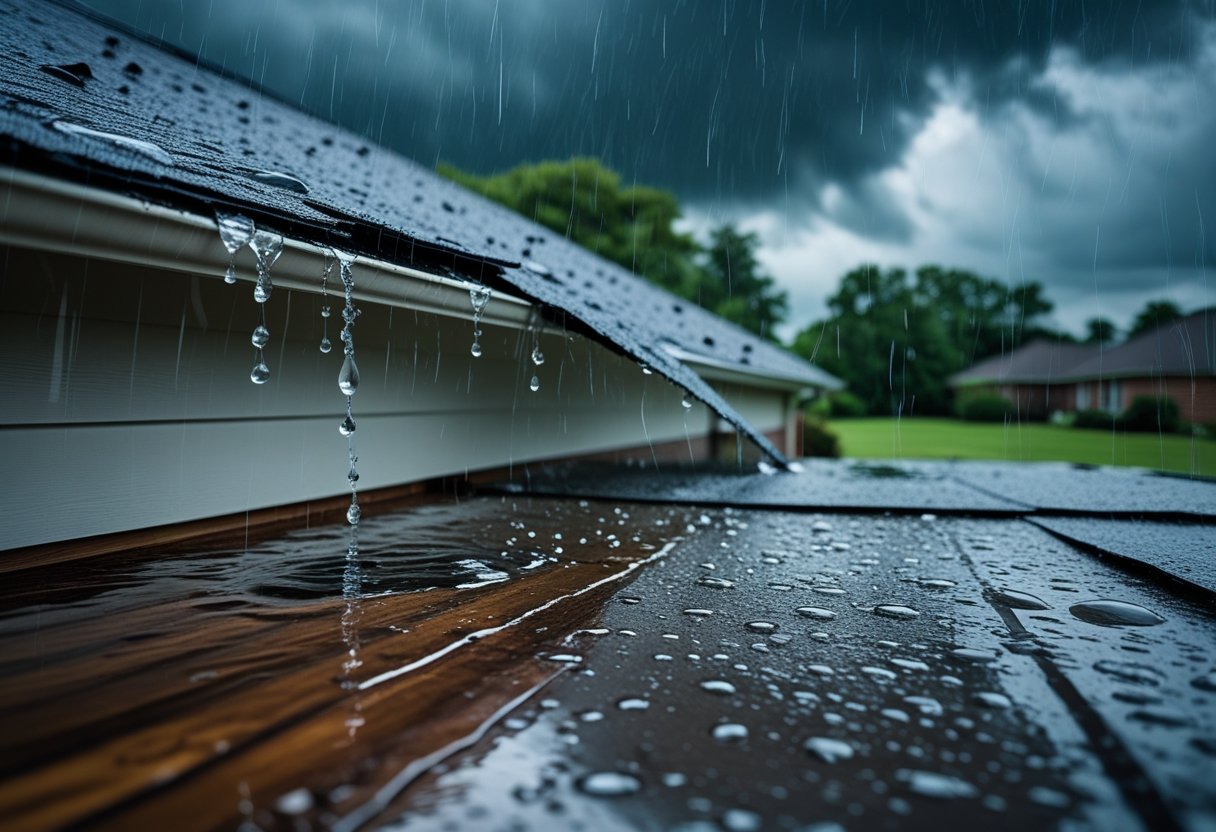Heavy storms can seriously damage your roof, leaving it open to leaks and expensive repairs. The best way to prevent roof leaks during storms is to regularly check and maintain your roof.
Make sure shingles are secure and there are no cracks or damages that could let water in. Keeping your roof in good shape before a storm hits helps protect your home.
You should also watch out for signs like missing shingles, dents from hail, or areas where water pools after rain. These issues can let water seep through, causing leaks inside your house.
Taking simple steps to fix small problems early on can save you money and a lot of hassle when storms come. If you live in or near Austin, Clear Choice Roofing is a trusted local company that can help with inspections and repairs.
Understanding Roof Leaks During Heavy Storms
Heavy storms bring strong winds, heavy rain, and hail that can damage your roof in many ways. This damage can create openings where water enters your home.
Knowing what causes these leaks and how storm damage leads to water entry helps you protect your home better.
Common Causes of Roof Leaks in Severe Weather
Storms can cause roof leaks in several ways. Strong winds can lift or tear off shingles, leaving gaps for water to enter.
Hail can leave dents or cracks in roofing materials, breaking protective layers. Heavy rain can make these weak spots worse.
Clogged gutters and downspouts also cause leaks. When water can’t drain properly, it pools on the roof or near the foundation.
Over time, this pooling can damage flashing, shingles, or the roof deck. Loose or damaged flashing around chimneys, vents, and skylights also lets water in.
These areas are prone to leaks if not sealed correctly or if damaged during a storm.
How Storm Damage Leads to Water Intrusion
When storms damage your roof, small cracks or holes allow water to move under shingles or through the roof deck. Water follows gravity and finds the weakest points to enter your home.
Even a tiny crack in roofing material can let water seep inside and cause leaks. Water damage inside your attic or walls may start slowly and get worse if not fixed quickly.
Storms can also damage the underlayment, the waterproof layer beneath shingles. If this gets damaged, water can reach wooden structures and cause rot or mold growth.
Flashing damage creates direct paths for water to pour in around roof penetrations.
Key things to watch for after a storm:
- Missing or loose shingles
- Dents or cracks from hail
- Wet spots or stains inside your home
- Damaged flashing or clogged gutters
Checking for these signs helps you catch leaks early.
Inspecting Your Roof Before Storms
Before a heavy storm hits, check your roof carefully to stop leaks and costly damage. Look for missing or broken shingles first, then check the flashing and sealant.
These steps help you catch problems early.
Checking for Damaged or Missing Shingles
Look for shingles that are cracked, curled, or missing. Damaged shingles can't protect your roof properly.
If you see granule loss, which looks like bald spots, the shingles are wearing out. Use a ladder to get a closer look, but stay safe.
You can also check from the ground with binoculars. Pay extra attention to areas where the roof meets walls or chimneys.
If you find damaged shingles, replace or repair them quickly. Missing shingles leave your roof open to leaks during storms.
Examining Flashing and Sealant Integrity
Flashing is the metal strip around chimneys, vents, and edges that seals joints. Check for cracks, bends, or rust.
Water can enter if flashing is loose or broken. Sealant, the caulk or roofing tar used to fill gaps, should be flexible and without cracks.
If sealant looks dry or missing, apply new sealant. Pay close attention to valleys where two roof slopes meet.
These are common leak points if flashing or sealant fails. Proper inspection and maintenance of these areas help your roof stay watertight during heavy rain.
Improving Roof Drainage
Good roof drainage keeps water moving off your roof and away from your home. This stops water from pooling or leaking inside during heavy storms.
You can do this by keeping gutters clear and making sure your roof has the right slope.
Cleaning Gutters and Downspouts
Gutters catch rainwater and direct it away from your roof and foundation. When leaves, dirt, and debris block them, water can overflow or stay standing.
This increases the chance of leaks and damage to your roof edges. Check your gutters at least twice a year, especially after stormy seasons.
Remove any leaves or clogs to make sure water flows freely. Also, clean downspouts to prevent blockages.
Use a ladder and gloves to clear debris safely. Installing gutter guards can help reduce cleaning.
Make sure downspouts lead water at least 3 feet away from your house to stop water from seeping near your walls or foundation.
Ensuring Proper Roof Slope
Your roof’s slope needs to be steep enough to let water run off quickly. If your roof is too flat or uneven, water can pool in low spots and cause leaks.
Most roofs should have at least a 2:12 pitch, meaning the roof rises 2 inches for every 12 inches across. This helps water slide off fast during storms.
If you notice water standing on your roof after rain, talk to a roofing professional about improving the slope or fixing any sagging areas. Proper roof framing and installation also affect drainage.
Good drainage protects shingles and the layers below.
Sealing Vulnerable Roof Areas
To keep your roof leak-free during heavy storms, focus on areas where water can sneak in easily. These spots include valleys and places where pipes or vents go through your roof.
Proper sealing and reinforcement here help stop leaks before they start.
Reinforcing Roof Valleys
Roof valleys are the channels where two roof slopes come together. Water flows fast through these, which can push past weak spots.
If the valley isn’t well sealed, water can seep under shingles and cause leaks.
To reinforce valleys:
- Use metal flashing to cover the valley. Metal is strong and directs water off the roof safely.
- Make sure flashing is securely nailed and sealed with waterproof caulk or roofing cement.
- Add an extra layer of underlayment under the valley flashing as a second barrier.
- Inspect valleys after storms for dents, cracks, or loose materials and fix them quickly.
Sealing Around Roof Penetrations
Pipes, vents, and chimneys break the roof surface and create spots for water to enter. These roof penetrations must be carefully sealed.
Steps to seal around penetrations:
- Use a flashing boot or collar that fits snugly around the pipe or vent.
- Apply roofing sealant around all edges. Keep the seal smooth and thick enough to fill any gaps.
- Check the sealant regularly, especially after storms, since it can crack or peel.
- Replace worn or damaged flashing to maintain a tight seal.
- For chimneys, use step flashing to overlap each row of shingles, directing water away.
By sealing all these gaps tightly, you stop water from entering weak points on your roof.
Protecting Attics and Interior Spaces
Keeping your attic dry and well-insulated stops leaks from causing damage inside your home. Good insulation controls temperature and moisture.
Proper ventilation prevents buildup that can lead to rot or mold.
Installing Proper Attic Insulation
The right insulation helps keep your attic temperature steady. This prevents ice dams in cold months and reduces heat buildup during hot weather.
Seal gaps and cracks where air can escape. Use materials that fit snugly between beams and rafters.
Good insulation reduces moisture problems that can cause wood to warp or decay. It also protects your ceilings and walls from water damage during heavy storms.
Ventilating Attic Spaces to Prevent Condensation
Proper ventilation lets moisture escape before it builds up and causes problems. Check that vents, soffits, and screens are clear of debris or damage.
Blocked vents trap moisture, leading to condensation on beams and insulation. A balanced system moves air through the attic—cool air enters through soffits, and hot moist air exits through ridge or roof vents.
This airflow keeps wood dry and stops mold growth. It also protects your insulation and helps prevent leaks from getting worse.
Maintaining Roof Materials for Longevity
To keep your roof strong and leak-free during heavy storms, care for the materials properly. This means cleaning your roof regularly and adding protective coatings that help stop water damage.
These steps extend your roof’s life and save you from costly repairs.
Regular Roof Cleaning
Dirt, leaves, and debris can build up on your roof and trap moisture. This can damage shingles or other roofing materials over time.
Cleaning your roof at least twice a year removes this buildup and helps prevent mold and algae growth. Use a soft brush or a low-pressure washer to clean the surface.
Avoid high pressure, which can damage shingles or tiles. Also, clear gutters and downspouts to ensure water flows away from your roof.
Regular cleaning helps you spot small problems early, such as cracked shingles or loose flashings. Fixing these right away keeps your roof strong during heavy rain and wind.
Applying Water-Resistant Coatings
Water-resistant coatings form a protective layer on your roof that blocks moisture. These coatings are especially helpful if your roof is older or made of porous materials like tile or wood.
Choose a coating designed for your roof type. For example, elastomeric coatings work well on metal and flat roofs.
You can apply these coatings yourself or hire a professional. Applying water-resistant coatings every few years seals small cracks and gaps.
It also protects against damage from ice, heat, and storms.
When to Call a Professional Roofer
Knowing when to get a pro involved can save you time and money. Some roof problems need expert tools and skills to fix.
Other times, picking the right contractor makes all the difference in quality and cost.
Identifying Signs That Require Expert Help
If you notice missing or torn shingles after a storm, call a roofer. Shingles protect the roof's structure, so damage can lead to leaks.
Look for cracks, dents from hail, or water stains inside your home. Water pooling on your roof after rain is another red flag.
It can cause the wood underneath to rot if not fixed quickly. Leaks often show as dark spots on ceilings or walls.
If your roof has more than a few damaged areas, a professional inspection is a smart choice.
Choosing the Right Roofing Contractor
Look for contractors with good reviews and local experience. A company that understands Austin’s weather and building codes will serve you better.
Check their ratings with the Better Business Bureau or Angi. Choose roofers who use high-quality materials and do not cut corners.
Ask if they are certified by trusted brands like Owens Corning. This shows they meet high standards and offer good warranties.
Make sure they offer a free estimate and help with insurance paperwork if needed. Good communication and respect for your home are signs of a company worth hiring.
Clear Choice Roofing is known for honesty, quality, and care in the Austin area.
Preparing for Future Storms
To protect your roof from heavy storms, schedule regular checkups and make plans for quick repairs. Staying proactive prevents small issues from becoming leaks that damage your home.
Scheduling Routine Roof Inspections
A professional should inspect your roof at least twice a year. Regular inspections help you find loose shingles, worn seals, or hidden damage that could let water in during storms.
Look for cracked shingles, gaps in flashing, and worn underlayment. Fixing problems early keeps rain and wind from making them worse.
Ask the inspector to check often-missed spots such as vents, chimneys, and roof edges. These areas commonly develop leaks.
Write down any repairs the inspector recommends. Set a timeline to complete them so you avoid bigger problems later.
Planning Emergency Repairs in Advance
Prepare a plan for quick roof repairs after a storm. Know which local roofers you can call if you see leaks or missing shingles.
Keep a list of trusted professionals, their contact information, and your insurance details. Having this ready helps you act fast and prevent more damage.
Store basic repair materials like tarps, roofing nails, and sealant. Use these to cover damaged areas temporarily until experts arrive.
Read your insurance policy to understand what roof damage it covers. Knowing your coverage helps you file claims and get repairs done quickly.
Frequently Asked Questions
You can protect your home by inspecting and maintaining your roof regularly. Prepare your roof before storms and know quick fixes to avoid major damage.
Sealing methods and insurance coverage information also help with storm-related roof problems.
What are the best ways to protect my home from roof leaks during severe storms?
Check your roof for loose or missing shingles. Clean gutters and downspouts so water flows away from your roof.
Trim nearby trees to keep branches from breaking your roof during strong winds.
What steps can I take to prepare my roof for upcoming heavy rains and potential storms?
Look for signs of damage like cracked or worn materials before storms arrive. Add water-resistant underlayment under shingles for extra protection.
Secure flashing around chimneys and vents to keep water out.
How can I stop an existing leak on my roof when it's already raining heavily?
Cover the area with a tarp if you can to block water. Place buckets under drips inside to catch water and protect your ceiling.
Avoid walking on a wet roof. Call a professional for repairs as soon as possible.
Are there any effective methods to seal a concrete roof to prevent water seepage?
Apply a waterproof sealant made for concrete roofs. Clean and dry the surface before sealing.
Check and reseal every few years to keep the roof water-tight.
Can you provide tips for fixing a roof leak from the exterior?
Find the leak location outside by looking for damaged areas. Remove damaged shingles and replace or patch them.
Use roofing cement to seal small cracks or holes.
Is storm-related roof damage typically covered by homeowners insurance?
Most policies cover sudden damage from storms like hail or wind. Review your policy and document any damage quickly.
Contact your insurance company to start a claim. They can help you with the process.



